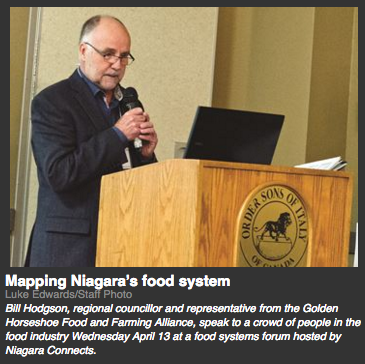The following article was written by Luke Edwards for Niagarathisweek.com, published on April 19, 2016, highlighting our asset mapping project.
 We could all use a lesson in food systems
We could all use a lesson in food systems
Grimsby Lincoln News
By Luke Edwards
When you think of the things you need to live – I mean really need – what springs to mind?
Not your cell phone or credit card, computer or cable TV package that includes 1,400 channels with nothing on. The things we all really need to live are pretty basic: shelter, water, heat and food. While we may not be doing the best jobs protecting and providing the first three of those, when it comes to the last one we’re way out there, lost in the middle of a 50-acre corn field, thinking it’s mighty tall wheat.
I spent last Wednesday morning at the Niagara Connects Food Landscape in Niagara forum. It was an event where people involved in the food chain – everything from growing tenderfruit to serving the peach pie – got together to map out what Niagara’s food system looks like. It was an eye-opening experience, to say the least.
Most people in the food sector live, more or less, in their own little silos, parden the pun. The farmer is so focused on growing her wheat or raising his pigs that they don’t really have time to think about the delicious apple pork chops that will result when said pig ends up at a Niagara Parks restaurant. Likewise, the chef’s only real interest in the farmer is to ensure the meat will taste the way it should.
But sit down and think about it, each person in that chain relies on an awful lot of people to keep the system running smoothly. From growers to distributers, wholesale and retail shops to purchasers, chefs and processing plants to the couple’s table. And it doesn’t end there. There’s the waste and disposal, putting what you can back into the system to grow next year’s crops.
Then there are the people on the outside looking in, who don’t have access to the vital food many of us take for granted every day.
Niagara’s food system, like any food system, is a complex web of connections. Unlike other industries there’s not necessarily a neat, linear pattern to follow, and an unexpected event – say a year of drought or disease – can have drastic impacts throughout the chain.
As Bill Hodgson said at Wednesday’s forum, those in every part of the food chain must routinely deal with the myths and urban legends about conventional farming and food production. But in order to fight back against those and educate the general public – unlike in past generations the vast majority of people today are completely removed from the food system – those on the inside must first understand Niagara’s food landscape themselves. The Niagara Connects forum, not to mention the work being done by groups like the Golden Horseshoe Food and Farming Alliance, helps.
It’s a scary thought to realize that a few years ago municipal planners would pull up information on all the food related properties in their town and look at a map that didn’t include a single farm – farms were excluded from said mapping. Luckily work done by the GHFFA means policy makers now have a clearer picture of their local food system, that is, their entire food system.
As Niagara’s food landscape is mapped internally, it’s time for those on the inside to look outward and correct the many food system myths floating around out there.
—–
See other recent articles from Niagara mentioning the GHFFA/asset mapping project:
Mapping Niagara’s food system | Niagarathisweek.com | April 15, 2016
Region-wide employment survey called key to economic development | Niagarathisweek.com | April 6, 2016
Region aims to map local employment | St. Catharines Standard | March 30, 2016
